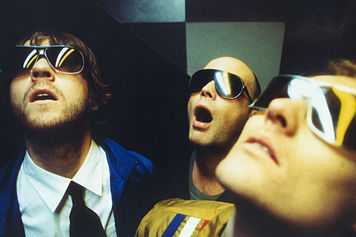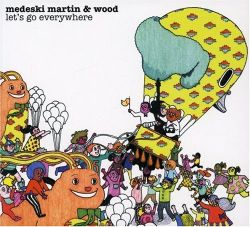There are few bands with which I have a longer ongoing relationship than jazz-funk-improv trio Medeski Martin & Wood. I think I’m one of the few people that started listening to them when their first album came out — Notes from the Underground, way back in 1991, when I was [gulp] a sophomore in college. That record was straight-up acoustic jazz, complete with horns and just enough hints of funk to attract a faux-hippie like yours truly. It only hinted at what was to come.
 Medeski Martin & WoodMMW’s second album, It’s a Jungle in Here, is in my top five of all time. I’ve probably heard it as many times, and in as many different phases of my life, as any piece of music ever. It’s like an old friend that knows embarrassing stories about me. In it, the band moved a little toward the modern — more organ and electric piano, more funk, more lean, hooky barn burners. For me, at least, it was the perfect balance. It’s never been topped.
Medeski Martin & WoodMMW’s second album, It’s a Jungle in Here, is in my top five of all time. I’ve probably heard it as many times, and in as many different phases of my life, as any piece of music ever. It’s like an old friend that knows embarrassing stories about me. In it, the band moved a little toward the modern — more organ and electric piano, more funk, more lean, hooky barn burners. For me, at least, it was the perfect balance. It’s never been topped.
The third, Friday Afternoon in the Universe, is another gem, in my top ten. They stripped down even further to a tight, funky trio, no guests, just thick organ, guttural base, and cosmically funky drums. This is the one I’d give somebody to introduce them to the band. It’s great soundtrack music; one track in particular, “Chubb Sub,” has shown up in at least three or four movies I can think of.
Then there was Shack Man, the last of the greats and probably the most accessible and dance-y. I did a great deal of hacky-sacking to this one, among other recreational activities.
Farmer’s Reserve was a sharp departure, a completely shapeless, beatless 50 unbroken minutes of formless free jazz improvisation, recorded on a lark (officially released only many years later). It obviously showed an increased appetite for improv, because their albums for the next few years included fewer and fewer structured, composed songs and more and more of what were clearly scraps of improvisation caught on tape. They added a DJ (DJ Logic) for a while and flirted with more electronic noise, and the following run of albums — Combustication, The Dropper, and Uninvisible — were crowded, hookless, and somewhat cold. (During this time there were also two live albums, the acoustic Tonic and the fanclub-only Electric Tonic, both of which were similarly challenging and not much fun.)
MMW hit their stride again in 2004 with the Dust Brothers-produced End of the World Party (Just In Case), which tightened the songs up a bit and put the funky groove back in. The title track is one of their best ever, a perfect marriage of head-nodding bop and dystopic postmodern atmospherics. (In 2006 they did Out Louder with guitarist John Scofield, but I never did get a chance to listen to it much.)
So there’s a historical tour for you, of interest to, um, probably no one. But I enjoyed it.
 Anyway! Imagine my surprise when I discovered that this year MMW would be putting out, of all things, an album of children’s music. Wacky! Wackier yet, Let’s Go Everywhere turns out to be awesome, no matter how old you are. There’s no condescending or simplifying for the kids, just a little more fun and whimsy. If you’re a parent like me and desperate to find kids’ music that doesn’t suck — it’s harder than you think — this is a gold mine.
Anyway! Imagine my surprise when I discovered that this year MMW would be putting out, of all things, an album of children’s music. Wacky! Wackier yet, Let’s Go Everywhere turns out to be awesome, no matter how old you are. There’s no condescending or simplifying for the kids, just a little more fun and whimsy. If you’re a parent like me and desperate to find kids’ music that doesn’t suck — it’s harder than you think — this is a gold mine.
Kind of cool to think that this band I started listening to when I was a kid is now making music for my kids. The circle of life, I tell you.
The song’s called “Where’s the Music?”

